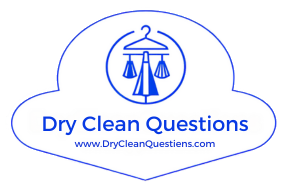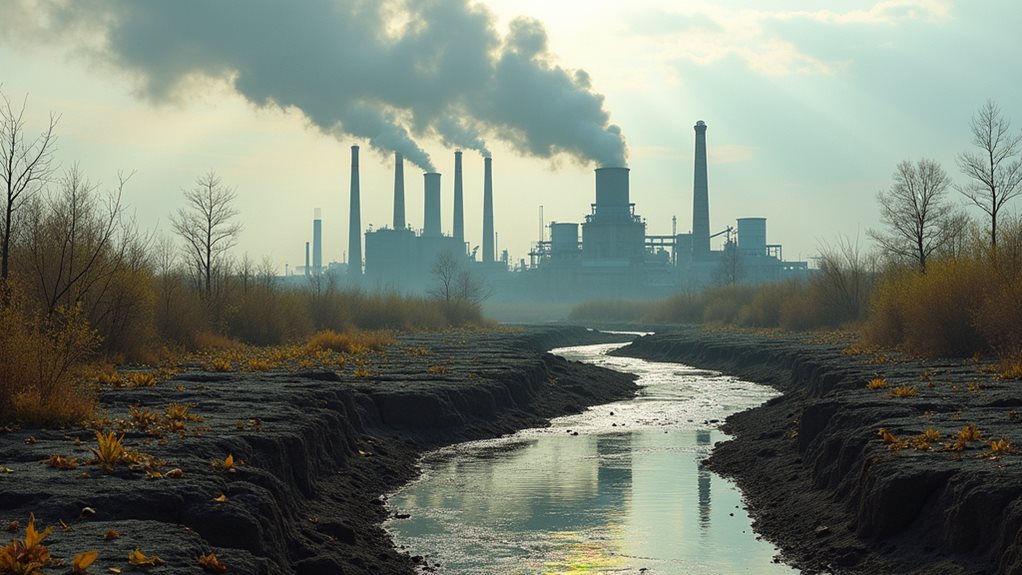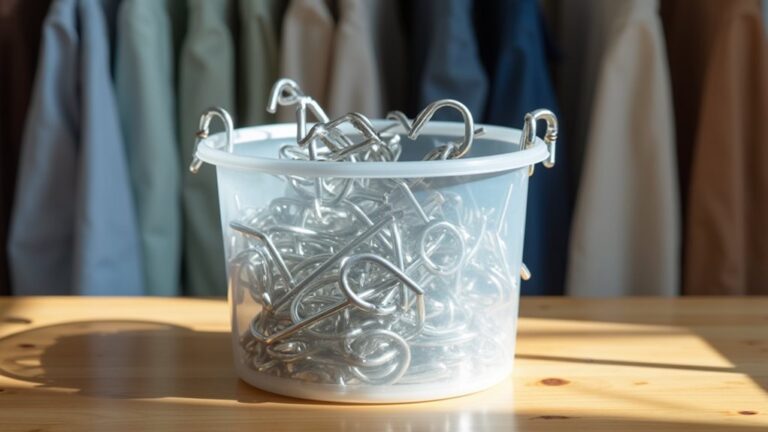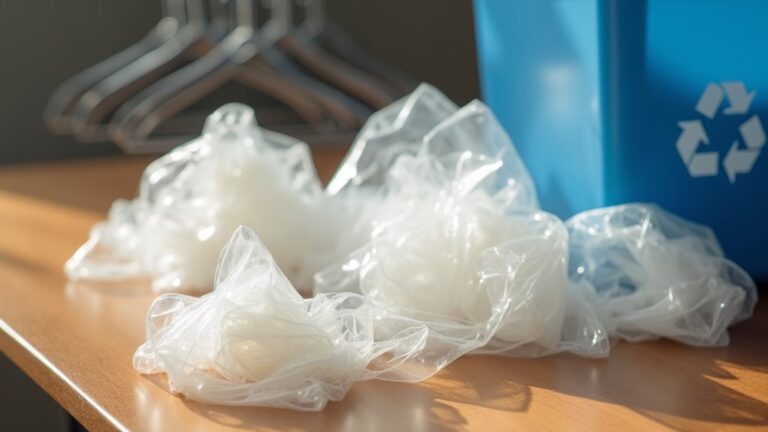Traditional dry cleaning wreaks havoc on your environment through perchloroethylene, a probable carcinogen used in 85% of America’s 35,000 shops that creates persistent groundwater pollution and contaminated air quality. You’re looking at facilities that generate over 650 gallons of hazardous waste annually, with 75% showing contamination that affects entire communities for decades. While green alternatives like professional wet cleaning exist, most cleaners still rely on these toxic chemicals that turn neighborhoods into contamination hotspots, and there’s much more to this environmental story.
Traditional Dry Cleaning Chemicals and Their Environmental Impact
Every week, millions of us drop off our favorite clothes at the dry cleaner without giving much thought to what happens behind those swinging doors, but the truth is that traditional dry cleaning relies heavily on perchloroethylene (PCE) – a chemical that’s both incredibly effective at removing stains and surprisingly dangerous to our health and environment.
These volatile organic compounds don’t just disappear after cleaning your silk blouse; they’re classified as probable carcinogens that create serious health risks for workers who handle them daily.
What’s even more concerning is how these toxic solvents seep into our groundwater, contaminating drinking water sources for entire communities.
With 75% of dry cleaners showing contamination and each facility generating over 650 gallons of hazardous waste annually, the environmental impact is staggering.
Studies have linked occupational exposure to PERC with increased risks of bladder cancer, esophageal cancer, and cervical cancer among workers in the dry cleaning industry.
Perchloroethylene: The Most Widespread Environmental Threat
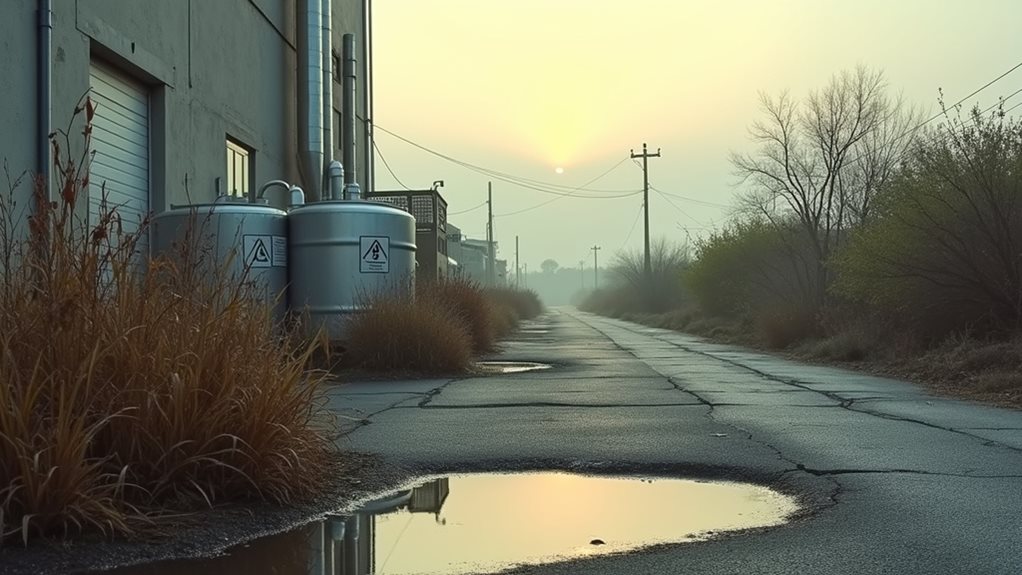
Behind 85% of America’s 35,000 dry cleaning shops, perchloroethylene quietly earns its reputation as the industry’s most dangerous workhorse, and honestly, the numbers around this chemical should make all of us pause the next time we’re rushing to pick up our freshly cleaned work clothes.
Behind those crisp, clean clothes lurks a probable carcinogen that should make every customer think twice.
This “probable” carcinogen doesn’t just vanish after cleaning your favorite suit—it creates groundwater pollution that persists for decades, turning dry cleaning facilities into environmental contamination hotspots.
The EPA has pinpointed these toxic solvents as major sources of volatile organic compounds, while studies reveal that 75% of dry cleaners harbor hazardous waste from improper handling.
The health risks extend beyond individual exposure, affecting entire communities through air and soil contamination that transforms the dry cleaning industry into an unwitting environmental threat.
Even customers face direct exposure risks when wearing freshly cleaned garments that haven’t been properly aired out, as PERC residues can cause neurological symptoms and respiratory irritation through prolonged contact with treated fabrics.
Groundwater Contamination From Dry Cleaning Operations
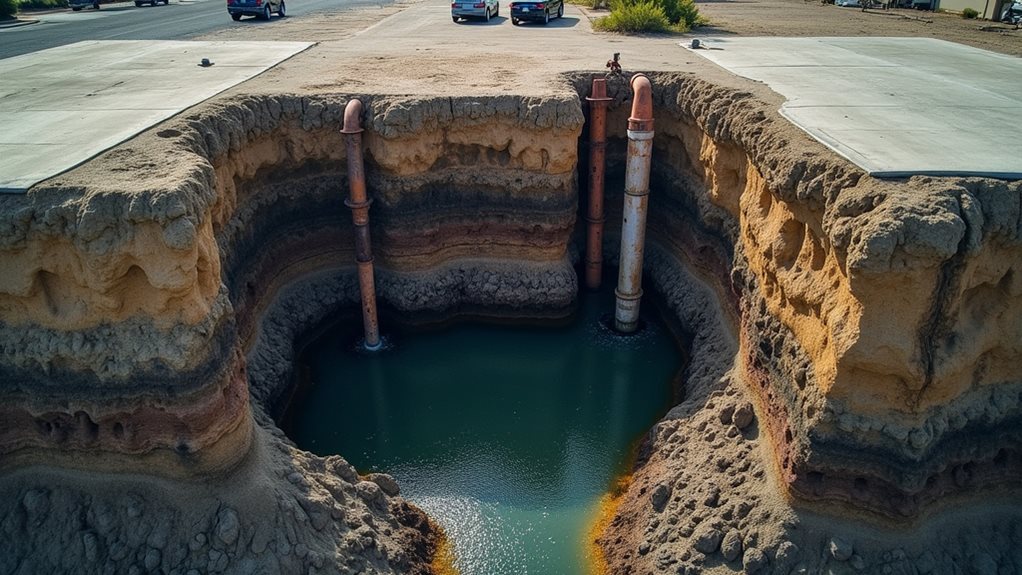
When my neighbor discovered that her well water tasted metallic and strange, she never imagined that the culprit might be lurking beneath the cheerful dry cleaner down the street—but that’s exactly how groundwater contamination works, silently spreading through underground aquifers like an invisible network of poison.
Here’s what you need to know: dry cleaning operations create serious environmental impacts when PCE and other hazardous chemicals leak from storage tanks, seeping deep into soil and contaminating groundwater for decades.
Studies show 75% of dry cleaners harbor contamination that poses real health risks to communities drinking affected water.
While regulatory agencies have established monitoring guidelines, enforcement varies wildly—leaving you vulnerable to long-term exposure that’s both expensive and dangerous to remediate.
Beyond groundwater concerns, PERC residues can remain on clothing even after the cleaning process, creating additional exposure pathways for consumers who wear contaminated garments.
Air Quality Issues and Vapor Intrusion Risks

When you’re dealing with dry cleaning facilities, you’ll discover that the contamination doesn’t just stay buried in the ground—it rises up like an unwelcome houseguest, creating serious indoor air problems that can make your home feel unsafe.
The volatile chemicals, especially that stubborn perchloroethylene, have this sneaky way of migrating through soil and seeping into buildings through foundation cracks, basement walls, and even concrete slabs, turning your supposedly safe indoor space into a potential health hazard.
What’s particularly concerning is how these vapor intrusion issues can persist for years, quietly elevating chemical levels in your home while you’re completely unaware, especially if you’re pregnant, nursing, or have young children who are more vulnerable to these invisible threats.
Beyond immediate air quality concerns, prolonged exposure to these chemical vapors has been linked to bladder cancer and other serious health conditions, making it crucial to understand the risks if you live or work near dry cleaning operations.
Indoor Air Contamination
Although you might think your freshly dry cleaned clothes only affect your wardrobe, they’re actually introducing a silent intruder into your home’s air that can linger for days or even weeks.
When you hang those crisp shirts in your closet, perchloroethylene and other dry cleaning solvents continue evaporating, creating indoor air pollution that transforms your sanctuary into something less safe.
These volatile organic compounds don’t just disappear—they accumulate, potentially reaching concentrations fifty times higher than outdoor levels, which honestly shocked me when I first learned it.
If you’re experiencing unexplained respiratory irritation or dizziness, your clothes might be the culprit.
Areas near dry cleaners face additional vapor intrusion from contaminated groundwater, amplifying health risks throughout entire neighborhoods.
Workers in cleaning facilities face the most severe exposure to these toxic solvents, experiencing significantly higher concentrations of perchloroethylene vapor than typical consumers.
Vapor Migration Dangers
The contamination problem extends far beyond your personal wardrobe, creating underground networks of chemical migration that can turn entire neighborhoods into unwitting victims of environmental hazards.
When perchloroethylene seeps into contaminated groundwater, it doesn’t just stay put—it travels through soil like an invisible river, eventually finding its way into your home through vapor intrusion.
These volatile organic compounds sneak through foundation cracks, degrading indoor air quality while you’re completely unaware.
The health risks are genuinely scary: prolonged exposure can lead to neurological problems and increased cancer risk.
The EPA has classified PERC as a probable human carcinogen, linking it not only to cancer but also to liver damage and reproductive issues that affect entire communities.
I’ve seen families discover their breathing issues stemmed from a dry cleaner blocks away, making this environmental hazard feel both distant and uncomfortably personal.
Waste Generation and Disposal Challenges
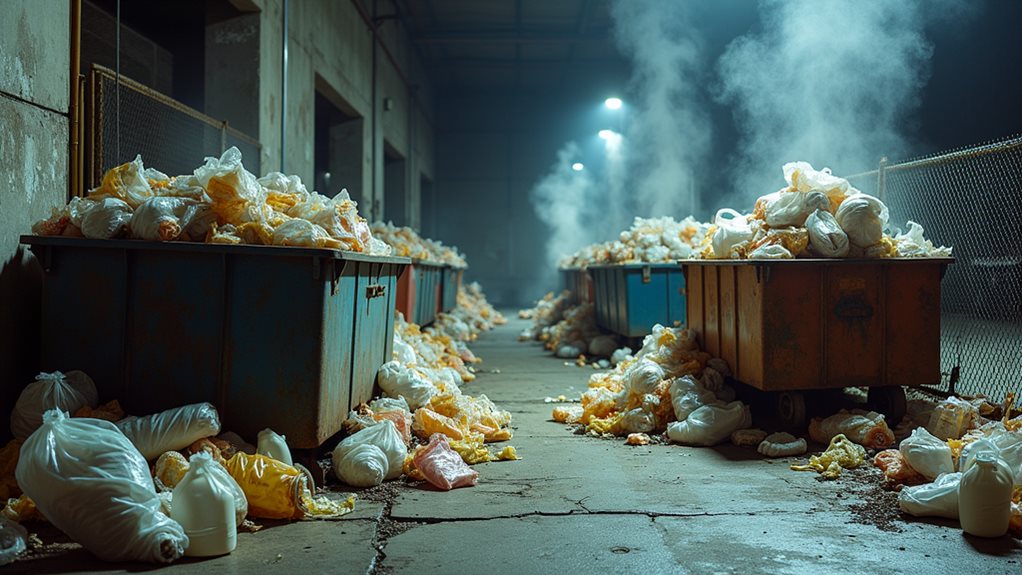
When you think about the mountains of waste your neighborhood dry cleaner generates, it’s honestly staggering—we’re talking about over 650 gallons of hazardous chemicals annually from just one average shop, and that’s not counting the contaminated filters, sludge, and soiled materials that pile up daily.
I’ll admit, I used to toss my favorite blazer to the cleaner without a second thought, blissfully unaware that many operators still dump this toxic cocktail improperly, creating environmental disasters that can linger for decades like unwanted house guests who refuse to leave.
You’ve probably driven past dozens of contaminated dry cleaning sites without realizing it, since roughly three-quarters of these businesses have polluted their surrounding areas, turning what should be simple garment care into a serious environmental challenge that affects entire communities.
The plastic garment bags that protect your freshly cleaned clothes add another layer to this waste problem, creating environmental burden that persists long after you’ve worn your outfit.
Hazardous Waste Volume
If you’ve ever wondered where all those chemical-soaked cleaning solutions disappear to after your favorite blazer gets its monthly refresh, you’re about to discover a sobering reality that’ll make you think twice about that “dry clean only” label.
Each dry cleaning business generates over 650 gallons of hazardous waste annually, with toxic solvents like PCE creating considerable public health concerns that ripple through entire communities.
What’s particularly troubling is that dry cleaners account for 36% of total PCE usage nationwide, and here’s the kicker – these chemicals don’t just vanish into thin air.
They seep into our groundwater, creating environmental pollution that persists for decades, affecting drinking water and ecosystems while most dry cleaning businesses struggle with responsible waste management practices.
Beyond liquid waste, the industry creates mountains of physical waste through single-use plastic garment bags and wire hangers that inevitably end up clogging our already overwhelmed landfills.
Improper Disposal Practices
Why do countless dry cleaning operations continue dumping toxic solvents down regular drains, tossing contaminated filters in standard dumpsters, and releasing chemical vapors directly into the air we breathe?
These improper disposal practices stem from three main culprits:
- Cost-cutting shortcuts that prioritize profits over environmental responsibility
- Inadequate training on proper hazardous waste management practices
- Inconsistent regulatory enforcement that lets violators slip through the cracks
When you’re dealing with perchloroethylene and other toxic chemicals, cutting corners creates serious environmental risks.
I’ve seen firsthand how these poor waste management practices lead to groundwater contamination that persists for decades 😔.
The resulting air pollution affects entire neighborhoods, while cleanup costs eventually fall on taxpayers like you and me.
Beyond these immediate environmental impacts, exposure to these improperly disposed chemicals can cause serious health problems including nervous system damage and liver complications for both workers and nearby residents.
Regulatory Response to Environmental Contamination
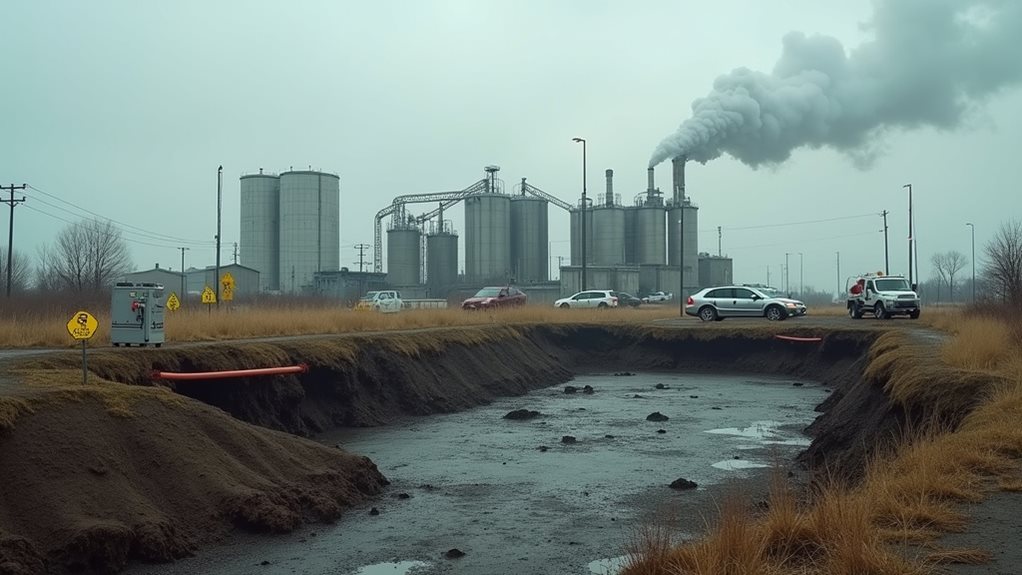
Although I’ve watched countless environmental scandals unfold over the years, the regulatory crackdown on dry cleaning contamination has been particularly swift and unforgiving, especially when you consider how long these businesses operated without meaningful oversight.
Regulatory agencies aren’t messing around anymore – they’ve implemented strict guidelines targeting hazardous solvents like perchloroethylene, and frankly, it’s about time.
If you’re a property owner near dry cleaning businesses, you’ll want to understand the contamination liabilities that can hit your wallet hard.
Environmental regulations are forcing the industry toward cleaner technologies, which honestly gives me hope 🌱.
While these changes create short-term pain for operators, they’re crucial for reducing long-term ecological impacts and protecting our communities from these toxic chemicals.
The push toward safer alternatives has led many eco-conscious dry cleaners to adopt methods like wet cleaning, liquid CO2 cleaning, and hydrocarbon solvents that significantly reduce environmental harm.
Green Alternatives Transforming the Industry
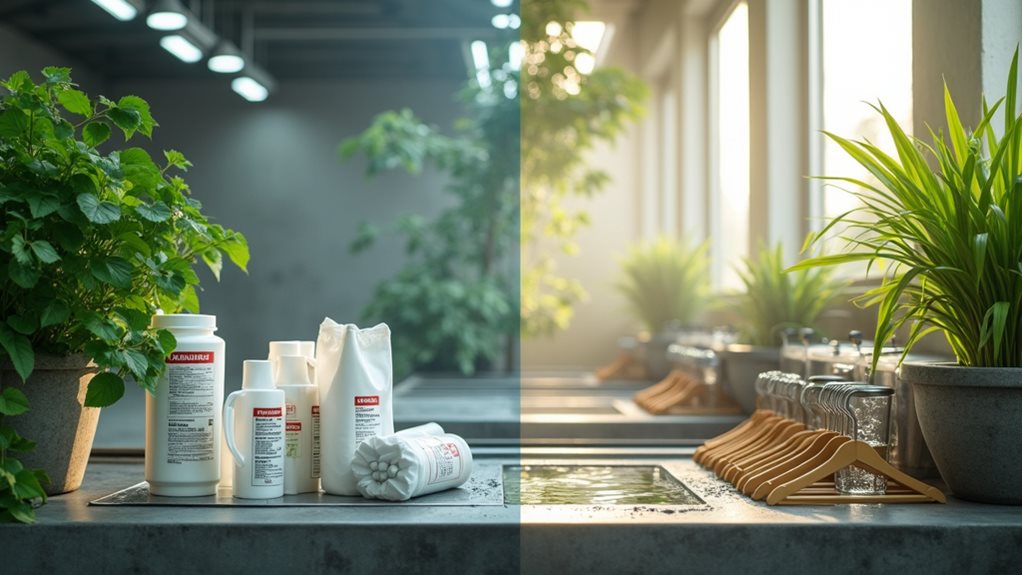
When I first heard about professional wet cleaning years ago, I’ll admit I was skeptical – how could water possibly replace those powerful chemical solvents that dry cleaners had relied on for decades?
Turns out, I was completely wrong about Green Dry Cleaning methods that are transforming this industry.
These innovative eco-friendly services are proving you don’t need harmful chemicals like perc to get your clothes spotless:
- Wet cleaning uses biodegradable detergents with water, protecting delicate fabrics while reducing environmental pollution
- Liquid carbon dioxide cleaning dissolves oils and dirt using pressurized CO2, minimizing greenhouse gas emissions
- Non-toxic solvents eliminate health risks while maintaining cleaning effectiveness
With 75% of U.S. cleaners still using dangerous chemicals, there’s room for improvement, but consumer demand is driving sustainable practices forward.
The Future of Environmentally Responsible Dry Cleaning
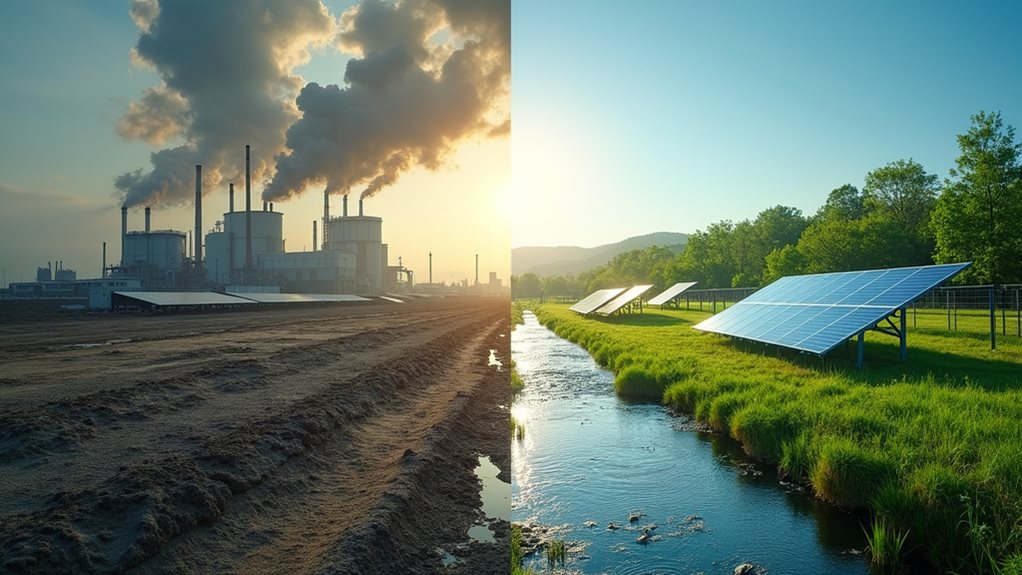
While change often moves slowly in traditional industries, the dry cleaning sector is experiencing a remarkable acceleration toward environmental responsibility that honestly gives me hope for our planet’s future.
You’re witnessing states like New Jersey and California leading the charge to phase out perchloroethylene (PERC), pushing the industry toward non-toxic alternatives that actually work.
Professional wet cleaning and liquid carbon dioxide methods are proving that environmentally friendly dry cleaning methods can deliver spotless results without the health risks.
Professional wet cleaning and liquid CO2 are revolutionizing the industry—proving eco-friendly methods can achieve flawless results without compromising your health.
What excites me most is watching consumer demand drive innovation—you’re literally voting with your wallet for biodegradable cleaning agents and eco-friendly solutions.
This shift toward green dry cleaning isn’t just trendy; it’s becoming the new standard. 🌱
